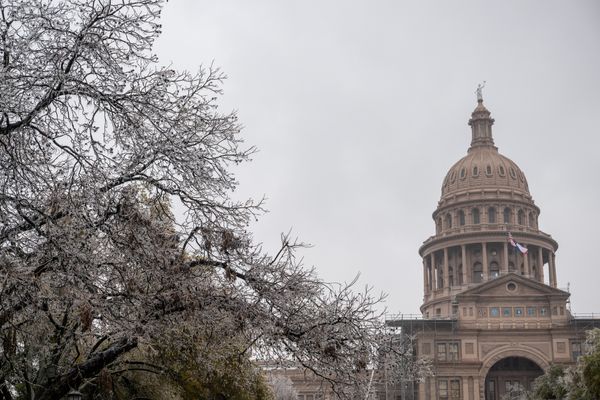
Over the past week, my breakfast routine has been scrambled. I have had overnight oats, beans on sourdough, corned-beef hash and fried rice, and, on a particularly weird morning, leftover cream-of-broccoli soup. Under normal circumstances, I would be eating eggs. But right now, I’m in hoarding mode, jealously guarding the four that remain from a carton purchased indignantly for six dollars. For that price—50 damn cents each!—my daily sunny-side-up eggs will have to wait. The perfect moment beckons: Maybe a toasted slab of brioche will call for a luxurious soft scramble, or maybe I will cave to a powerful craving for an egg-salad sandwich.
Eggs, that quintessential cheap food, have gotten very, very expensive in the United States. In December, the average price for a dozen eggs in U.S. cities hit an all-time high of $4.25, up from $1.78 a year earlier. Although the worst now seems to be behind us, there’s still a ways to go before consumer prices hit reasonable levels—and Americans are starting to crack. Online, the shortage has recently hatched endless memes: In some posts, people pretend to portion out eggs in plastic baggies, like drug dealers (Pablo Eggscobar, anyone?); another recurring bit suggests painting potatoes to hunt at Easter. The high prices have even led to egg smuggling and raised the profile of “rent-a-chicken” services, where customers can borrow hens, chicken feed, and a coop for a couple hundred bucks.
Surging egg prices are partly a familiar story of pandemic-era inflation. Producing eggs costs more because fuel, transportation, feed, and packaging are more expensive now, Jada Thompson, an agricultural economist at the University of Arkansas, told me. And it doesn’t help that there are no great substitutes for eggs. But a big reason prices are so high right now is the avian flu—a virus that infects many types of birds and is deadly for some. Right now, we’re facing the worst-ever wave in the U.S.; it has decimated chicken flocks and dented America’s egg inventory. Over just the past year, more than 57 million birds have died from the flu. Some much-needed relief from sky-high egg prices is likely coming, but don’t break out the soufflé pans yet. All signs suggest that avian flu is here to stay. If such rampant spread of the virus continues, “these costs are not going to come down to pre-2022 levels,” Thompson told me. Cheap eggs may soon become a thing of the past.
This isn’t the first time American egg producers have encountered the avian flu, but dealing with it is still a challenge. For one thing, the virus keeps changing. It has long infected but not killed waterfowl and shorebirds, such as ducks and geese, but by 1996, it had mutated into the “highly pathogenic” H5N1, a poultry-killing strain that is named for the nasty versions of its “H” and “N” proteins. (They form spikes on the virus’s surface—sound familiar?) In 2014 and 2015, H5N1 ignited a terrible outbreak of avian flu, which gave U.S. poultry farmers their first taste of just how bad egg shortages could get.
But this outbreak is like nothing we’ve seen before. The strain of avian flu that’s behind this wave is indeed new, and in the U.S., the virus has been circulating for a full year now—far longer than during the last big outbreak. The virus has become “host-adapted,” meaning that it can infect its natural hosts without killing them; as a result, wild waterfowl are ruthlessly efficient at spreading the virus to chickens, Richard Webby, the director of the World Health Organization Collaborating Center for Studies on the Ecology of Influenza in Animals and Birds, told me.
Many of these wild birds are migratory, and during their long journeys between Canada and South America, they descend on waterways and poop virus from the sky over poultry farms. Chickens stand no chance: The fleshy flaps on their heads may turn blue, their eyes and neck may swell, and, in rare instances, paralysis occurs. An entire poultry flock can be wiped out in 48 hours. Death is swift and vicious.
Everything about this current wave has aligned to put a serious dent in our egg supply. Most eggs in the United States are hatched in jam-packed industrial egg farms, where transmission is next to impossible to stop, so the go-to move when the flu is detected is to “depopulate,” the preferred industry term for killing all of the birds. Without such a brutal tactic, Bryan Richards, the emerging-disease coordinator at the U.S. Geological Survey, told me, the current wave would be much worse.
But this strategy also means fewer eggs, at least until new chicks grow into hens. That takes about six months, so there just haven’t been enough hens lately—especially for all the holiday baking people wanted to do, Thompson said. By the end of 2022, the U.S. egg inventory was 29 percent lower than it had been at the beginning of the year. The chicken supply, in contrast, is robust, because avian flu tends to affect older birds, like egg layers, Thompson said; at six to eight weeks old, the birds we eat, known as broilers, are not as susceptible. Also, she added, wild-bird migration pathways are not as concentrated in the Southeast, where most broiler production happens.
Egg eaters should be able to return to their normal breakfast routines soon enough. New hens are now replenishing the U.S. egg supply—while waterfowl are wintering in the warmer climes of South America rather than lingering in the United States. Since the holidays, “the price paid to the farmers for eggs has been decreasing rapidly, and usually, in time, the consumer price follows,” Maro Ibarburu, a business analyst at Iowa State University’s Egg Industry Center, told me.
Still, going forward, it may be worth rethinking our relationship with eggs. There’s no guarantee that eggs will go back to being one of the cheapest and most nutritious foods. When the weather warms, the birds will return, and “it’s highly likely that upon spring migration, we could see yet another wave,” Richards said. Europe, which experienced the H5N1 wave about six months before the Americas did, offers a glimpse of the future. “They went from being in a situation where the virus would come and go to a position where, essentially, it came and stayed,” Webby told me. If we’re lucky, though, birds will develop a natural immunity to the virus, making it harder to spread, or the U.S. could start vaccinating poultry against the flu, which the country has so far been reluctant to do.
Omelets aside, curbing the spread of avian flu is in our best interest, not just to help prevent $6 egg cartons, but also to avoid a much scarier possibility: the virus spilling over and infecting people. All viruses from the influenza-A family have an avian origin, noted Webby; a chilling example is the H1N1 strain behind the 1918 flu pandemic. Fortunately, although some people have been infected with H5N1, very few cases of human-to-human spread have been documented. But continued transmission, over a long enough period, could change that. The fact that the virus has recently jumped from birds to mammals, such as seals and bears, and spread among mink is troubling, because that means that it is evolving to infect species that are more closely related to us. “The risk of this particular virus [spreading among humans] as it is now is low, but the consequences are potentially high,” Webby said. “If there is a flu virus that I don’t want to catch, this one would be it.”
More than anything, the egg shortage is a reminder that the availability of food is not something we can take for granted going forward. Shortages of staple goods seem to be striking with more regularity not only due to pandemic-related broken supply chains and inflation, but also because of animal and plant disease. In 2019, swine fever decimated China’s pork supply; the ongoing lettuce shortage, which rapper Cardi B bemoaned earlier this month, is the result of both a plant virus and a soil disease. Last September, California citrus growers detected a virus known to reduce crop yields. By creating cozier conditions for some diseases, climate change is expected to raise risk of infection for both animals and plants. And as COVID has illustrated, any situation in which different species are forced into abnormally close quarters with one another is likely to encourage the spread of disease.
Getting used to intermittent shortages of staple foods such as eggs and lettuce will in all likelihood become a normal part of meal planning, barring some huge shift away from industrial farming and its propensity for fostering disease. These farms are a major reason certain foods are so inexpensive and widely available in the first place; if cheap eggs seemed too good to be true, it’s because they were. Besides, there are always alternatives: May I suggest cream-of-broccoli soup?







